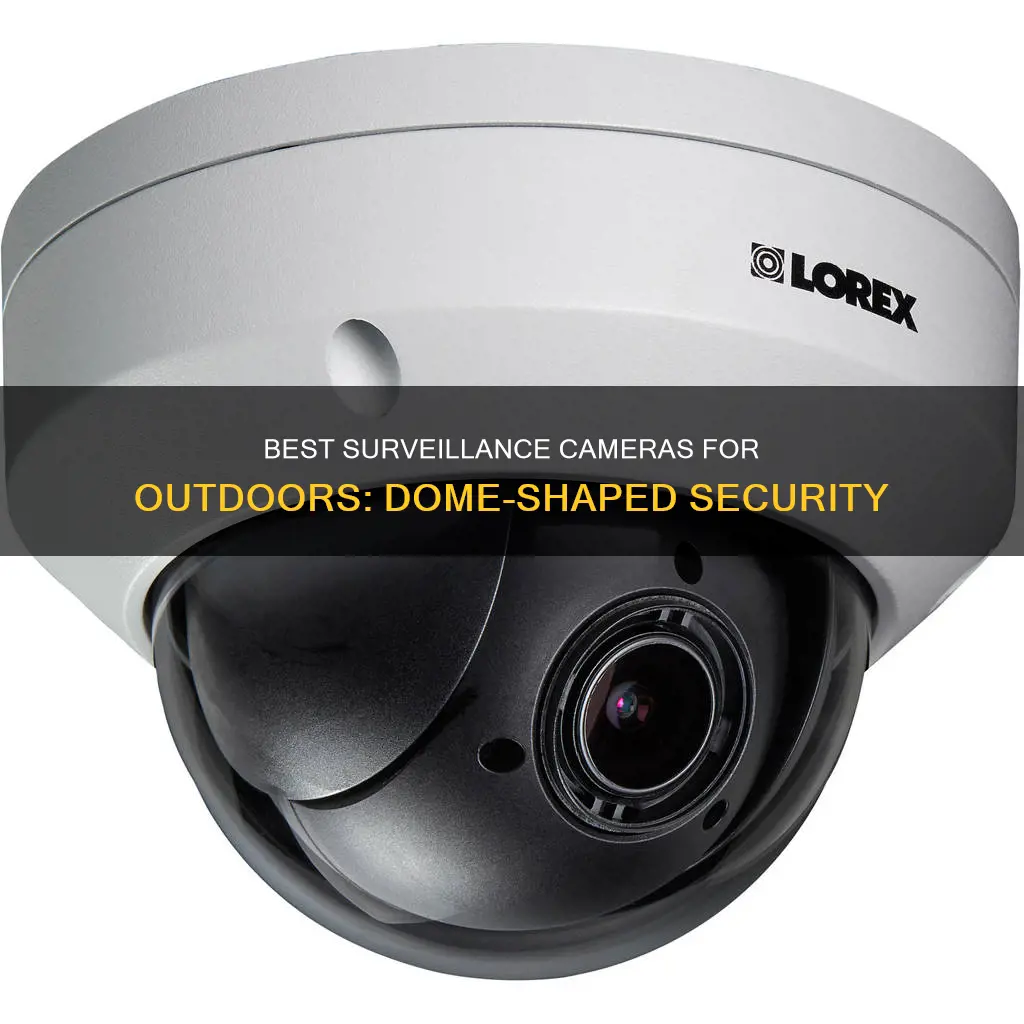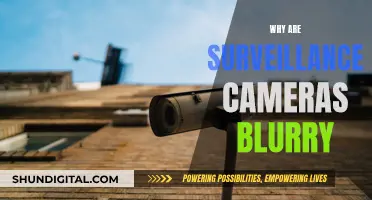
Dome cameras are a versatile and highly adaptable security option, suitable for both indoor and outdoor use. They are named for their distinctive dome-shaped housing, which provides protection from vandalism and the elements. With a range of features, including night vision, weatherproofing, and wide-angle lenses, dome cameras are an effective deterrent against crime and offer superior surveillance capabilities for homes and businesses alike.
| Characteristics | Values |
|---|---|
| Use case | Indoor and outdoor |
| Design | Sleek, discreet, low-profile, compact |
| Vandal-proof | Yes |
| Weatherproof | Yes |
| Water-resistant | Yes |
| Night vision | Yes |
| Resolution | 2MP, 3MP, 4K, 8MP, 1080p |
| AI-enabled | Yes |
| Installation | Easy, tool-free |
| Mounting | Ceiling, wall |
What You'll Learn

Vandal-proof and weatherproof
Dome cameras are designed to be vandal-proof and weatherproof, making them ideal for both indoor and outdoor use. The vandal-resistant casing on dome cameras protects against tampering and light blows, making them perfect for high-traffic areas like apartment or school hallways. The casing is typically made of a solid metal base and a vandal-resistant polycarbonate plastic cover. Once installed, these cameras are difficult to tamper with as they are completely enclosed and require special tools to open.
The dome-shaped cover also provides protection from the elements, including rain, snow, and dust. This makes them suitable for outdoor environments with a high risk of inclement weather. Most outdoor models carry an IP rating of IP65, IP66, or IP67, indicating their ability to withstand harsh weather conditions.
In addition to the weatherproof cover, many outdoor dome cameras also feature integrated temperature gauges and heaters, allowing them to operate in extreme temperatures. This makes them a reliable choice for surveillance in rugged conditions.
The durability of a vandal-proof dome camera is often indicated by its IK rating, which ranges from IK00 to IK10. A higher IK rating means greater impact resistance. For example, a camera with an IK10 rating can withstand up to 20 joules of impact, equivalent to a 5kg mass dropped from 40cm.
The combination of vandal-proof and weatherproof features makes dome cameras a popular choice for areas that require a high level of security, such as airports and government buildings. They are also commonly used in businesses and homes due to their effectiveness in deterring theft and vandalism.
AI Camera Focus: Revolutionizing Photography with Intelligence
You may want to see also

Night vision
Some dome cameras offer colour night vision, providing clearer and more detailed footage. For example, the Kasa 2K QHD Security Camera and the REOLINK RLC-823S2 Smart 4K/8MP UHD PTZ Dome Security Camera both feature colour night vision.
When choosing a dome camera for outdoor use, it is important to consider the lighting conditions of the area you wish to monitor. If the area is not well-lit, ensure you select a camera with night vision capabilities to ensure effective surveillance.
In addition to night vision, other key considerations for outdoor dome cameras include vandalism and weather resistance. Many dome cameras have a sturdy, vandal-proof design and are rated IP65, IP66, or IP67 for water resistance, making them suitable for use in various weather conditions.
Dome cameras are a versatile choice for both indoor and outdoor surveillance, offering high resolution, discrete positioning, and wide-angle monitoring.
Understanding RAW Photography: Does Your Camera Support It?
You may want to see also

Wide-angle lens
Dome surveillance cameras with wide-angle lenses are a great option for those looking to secure large areas, like entryways and garages. These cameras can provide a field of view of up to 180 or even 360 degrees, capturing a much larger area than traditional cameras.
The wide-angle lens in dome surveillance cameras offers a number of benefits. Firstly, it increases the coverage area, reducing the number of cameras needed for larger spaces. This, in turn, reduces the costs associated with purchasing and installing multiple security cameras. Additionally, the wide-angle lens captures additional details about subjects in range, as more of the space is visible.
However, one drawback of super wide-angle dome cameras is image distortion, especially in fisheye cameras. Also, super wide-angle lenses may sacrifice some details to achieve wider viewing angles, making it harder to identify specific details like faces or license plate numbers.
To address this issue, you can opt for a PTZ (pan, tilt, zoom) or dual-lens dome camera. These cameras provide a super-wide view with minimal distortion. PTZ dome cameras are ideal for monitoring large areas like parking lots, as they can be remotely adjusted to zoom in and out and capture specific details. On the other hand, dual-lens dome cameras use two lenses, either identical or different, to provide a wide-angle view without distortion.
When choosing a dome surveillance camera with a wide-angle lens, it's important to consider the focal length of the lens and the size of the image sensor, as these factors determine the field of view. A shorter focal length will result in a wider field of view, and a larger image sensor will also contribute to a wider viewing angle. Additionally, you can choose between analog and IP (internet protocol) cameras, as well as fixed lens and varifocal lens options, depending on your specific needs and budget.
The Evolution of Cameras: From First Invention to Now
You may want to see also

Indoor and outdoor use
Dome cameras are highly versatile and can be used for indoor and outdoor surveillance. They are suitable for a range of locations, including homes, retail stores, restaurants, schools, banks, and construction sites.
Dome cameras are an ideal choice for both indoor and outdoor use due to their design and features. The dome shape provides a low-profile and less invasive solution, making them popular for public areas as it is harder to determine the direction in which the camera is pointing. This cover also offers protection from the elements, with outdoor models often featuring an IP rating that indicates their ability to withstand harsh weather conditions.
Additionally, dome cameras are known for their durability and vandal-resistant properties, making them suitable for high-traffic areas and offering protection against theft and vandalism. They are also equipped with features such as night vision and varifocal lenses, enhancing their functionality in both indoor and outdoor settings.
When choosing a dome camera for indoor or outdoor use, consider factors such as resolution, infrared night vision capabilities, and whether you require audio recording. For outdoor use, ensure the camera has weather-resistant and vandal-proof capabilities, with an appropriate IP rating to withstand the outdoor environment.
Dome cameras offer a versatile and discreet option for indoor and outdoor surveillance, providing effective security monitoring in a range of environments.
Understanding the Size of Raw Camera Files
You may want to see also

Installation
Installing a dome surveillance camera outdoors requires careful planning and execution. Here is a step-by-step guide to help you through the installation process:
Planning:
Before you begin, it is essential to create a plan by mapping out the priority areas and the desired angles for your camera. Consider factors such as clear lines of sight, protection from the elements, and access to a power source if you are using a wired camera.
Preparing the Camera:
Download the camera's accompanying app, if available, to your smartphone. This will allow you to set up and configure the camera before mounting it. Connect the camera to your Wi-Fi network and pair it with the app. You will also need to provide your Wi-Fi SSID and password so that the camera can connect.
Mounting the Camera:
Prepare the camera mount by using the provided drill template to mark the correct placement of holes. Drill pilot holes at the mounting screw indicators and install any necessary mounting pins by tapping them lightly with a hammer. Securely screw the camera mount into the wall.
Installing the Camera:
Connect the camera to the mount and adjust it to the desired angle. Use the app to check the camera's point of view and make any necessary adjustments. Test the camera to ensure it captures movement effectively, has the desired range for night vision, and has clear audio.
Additional Considerations:
- Choose a dry day for installation to prevent moisture from becoming trapped between the lens and cover, which can impair night vision performance.
- If you are using a wired camera, you may need to drill a hole in the wall to run the cable through.
- Ensure the camera is positioned away from direct sunlight to avoid glare and in a location that provides some protection from harsh weather conditions.
- For cameras with a dome cover, clean the lens with a lint-free cloth before reinstalling the cover to remove any dirt, fingerprints, or dust that may impact the video quality.
- Be mindful of the legal considerations regarding the placement of outdoor security cameras to avoid invading your neighbour's privacy.
Garry's Mod Camera Mode: A Step-by-Step Guide
You may want to see also







